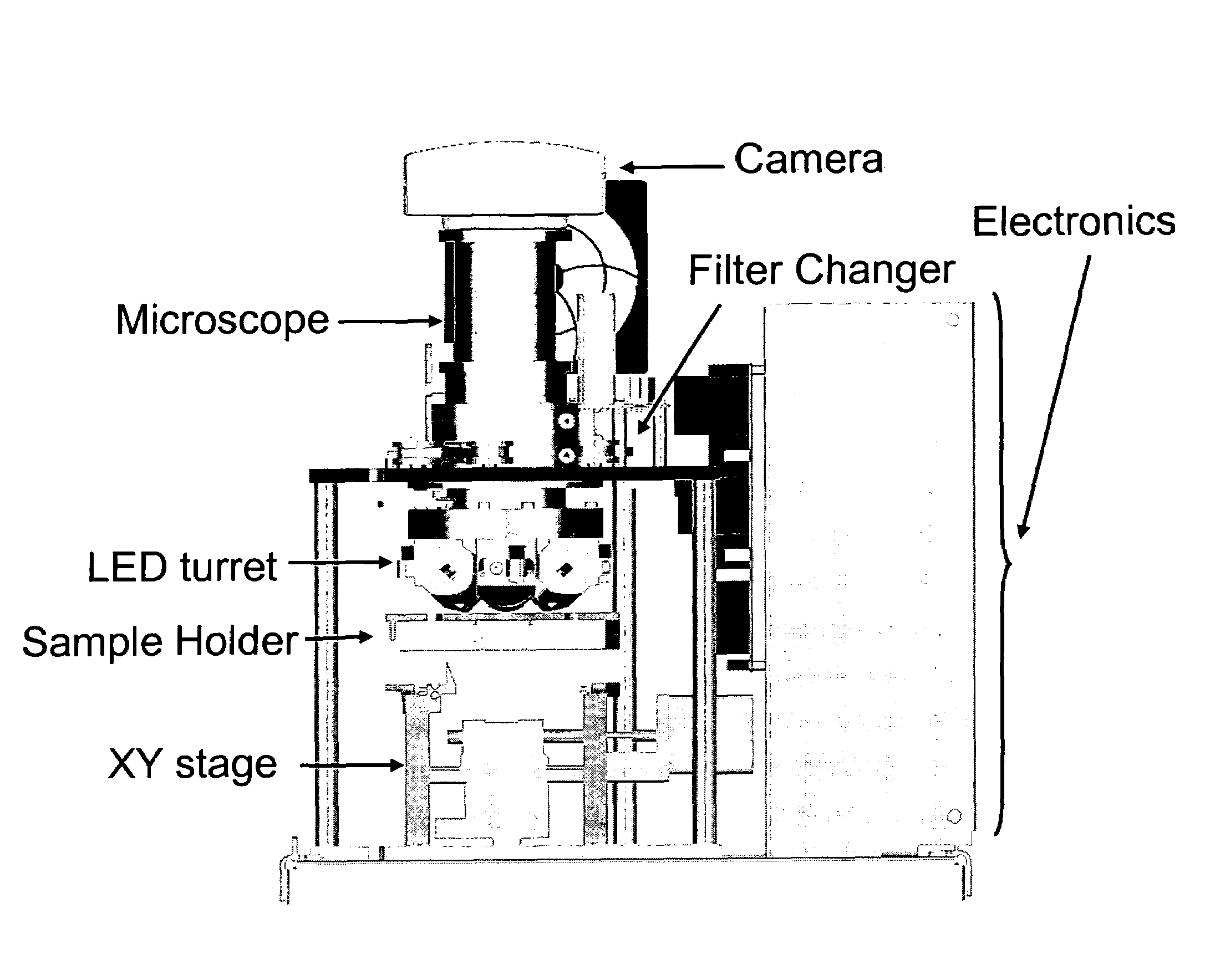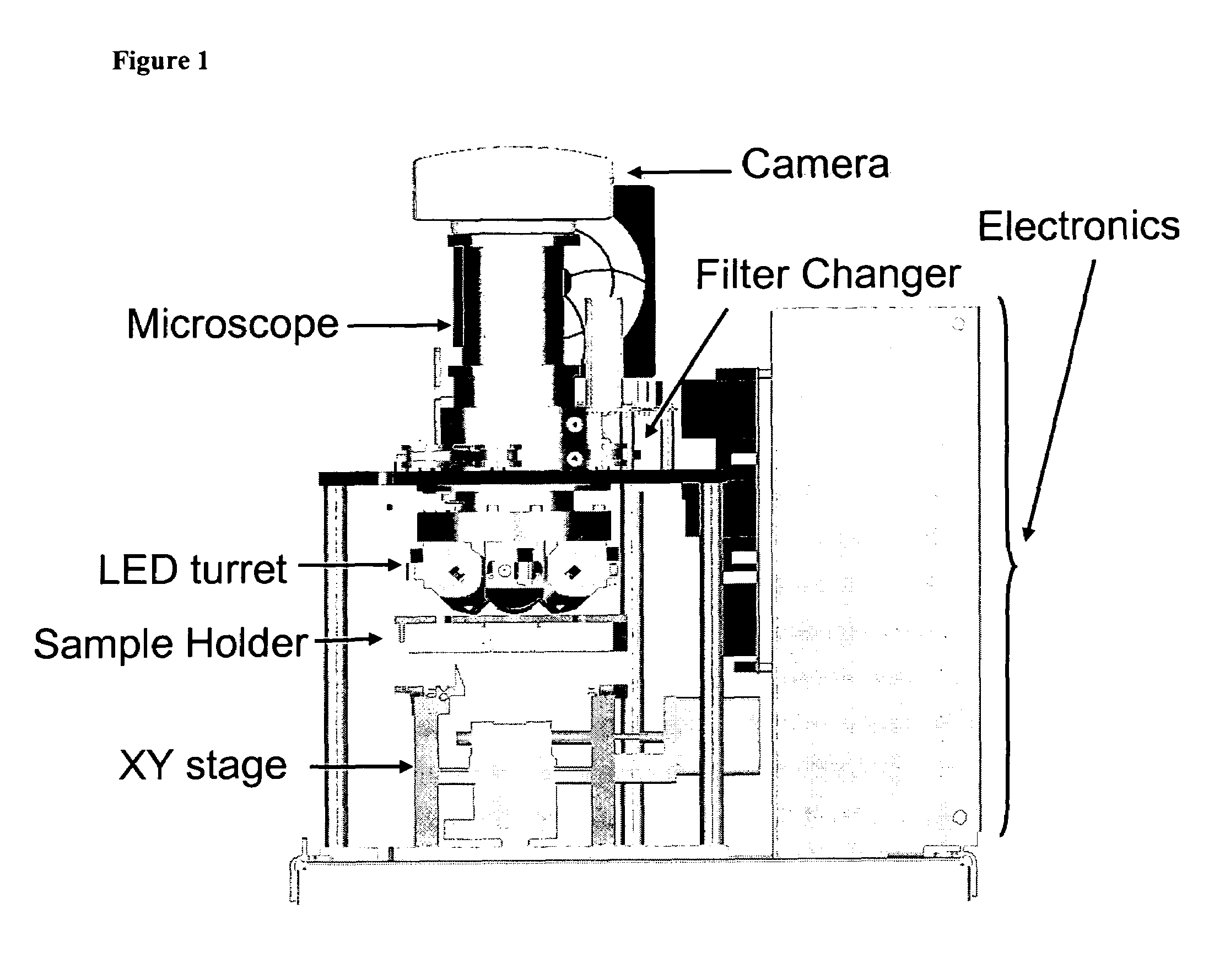Methods and algorithms for cell enumeration in a low-cost cytometer
a low-cost, cell-enumeration technology, applied in the direction of biomass after-treatment, specific use bioreactors/fermenters, instruments, etc., can solve the problems of inaccessibility to routine clinical use of flow cytometry and similar complex analytical systems, lack of robustness, limitations, etc., to achieve low cost, low cost, and simple design
- Summary
- Abstract
- Description
- Claims
- Application Information
AI Technical Summary
Benefits of technology
Problems solved by technology
Method used
Image
Examples
example 1
[0049]Cell enumeration is commonly performed using expensive flow cytometry (FC) or less accurate manual count methods. Here, we present an automated microscope device to obtain absolute cell counts based on fluorescence with cell identification not prone to operator to operator variability of manual cell counts.
[0050]The device of the present invention, EasyCount (EC), is a simple fluorescence microscope coupled to an on board microcomputer. It has a 5× objective (NA 0.1) and 4 high power LEDs for excitation at two different wavelengths. Each LED is equipped with an excitation filter and a collection lens for the stray light. The LEDs are placed next to the objective lens and illuminates the sample directly. Available illumination wavelengths are 490, 530 and 590 nm. Detection is performed by capturing a fluorescent image from a field of view of 0.95×1.3 mm on a 16 bit camera. The light is collected by the objective and selected by emission filters. The illumination and detection w...
example 2
[0055]Cells from the prostate cell line PC3-9 were harvested and resuspended in RPMI culture media. Cell count and viability determination by hemacytometer involved mixing cells 1:1 with trypan blue. Cells to be counted on EasyCount were mixed 1:1 with a cocktail containing acridine orange and ethidium bromide. Samples were then loaded onto the ViaSure™ slide, placed on the EasyCount platform, and viable and non-viable counts were obtained. Cells at concentrations ranging from 2×104 / ml through 5×106 / ml were analyzed for total cell counts using both the hemacytometer and EasyCount. Regression analysis of the data showed an R2 of 0.999 with a slope of 1.2. At the upper end of the titration curve, hemacytometer counts required an additional dilution step which was not necessary with EasyCount. Regression analysis of the EasyCount assay linearity showed an R2 of 0.97 with a slope of 0.99. Correlation of sample viability involved making mixtures of cells with viabilities of approximately...
example 3
[0056]Counting residual leukocytes in leukodepleted blood products is done using either a specialized hemacytometer (Nageotte) or by flow cytometry on nucleic acid-stained samples. Nageotte counting is tedious and labor-intensive. Flow cytometry requires expensive instrumentation, a skilled operator, and has low sample throughput. The fluorescent imaging system of the present invention is useful for counting low numbers of residual leukocytes in leukodepleted blood products.
[0057]One hundred microliters of blood were mixed with anti-CD45-ferrofluid and a fluorescent stain to visualize the cells. A variety of fluorescents stains were evaluated among which nucleated acid dyes and anti-CD45-PE. Leukocytes were magnetically mounted in a CellTracks® cartridge and MagNest® and imaged using either an EasyCount Cell Counter or a fluorescent microscope. The number of leukocytes present was also measured by flow cytometry (BD LeukoCount) and by Nageotte chamber.
[0058]Using ACD whole blood sam...
PUM
 Login to View More
Login to View More Abstract
Description
Claims
Application Information
 Login to View More
Login to View More - R&D
- Intellectual Property
- Life Sciences
- Materials
- Tech Scout
- Unparalleled Data Quality
- Higher Quality Content
- 60% Fewer Hallucinations
Browse by: Latest US Patents, China's latest patents, Technical Efficacy Thesaurus, Application Domain, Technology Topic, Popular Technical Reports.
© 2025 PatSnap. All rights reserved.Legal|Privacy policy|Modern Slavery Act Transparency Statement|Sitemap|About US| Contact US: help@patsnap.com



